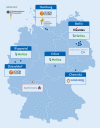[Evaluation of the COVID-19 vaccination after broad implementation-an interim conclusion for Germany in July 2022]
- PMID: 36355192
- PMCID: PMC9648427
- DOI: 10.1007/s00103-022-03618-8
[Evaluation of the COVID-19 vaccination after broad implementation-an interim conclusion for Germany in July 2022]
Abstract
Vaccines against COVID-19 have been available in Germany since December 2020. At the Robert Koch Institute (RKI), the Immunization Unit is responsible for monitoring vaccination coverage and assessment of vaccine effectiveness. This article provides an overview of the respective reporting structures, vaccination databases, and epidemiological studies established by the Immunization Unit during the COVID-19 pandemic. We describe the COVID-19 Digital Vaccination Coverage Monitoring (DIM), which provides daily updates on vaccination coverage by age group. We next describe how, based on the DIM data and COVID-19 case data, the assessment of vaccine effectiveness against different clinical endpoints (hospitalization, intensive care, death) is performed. While this method is used for a preliminary estimate of vaccine efficacy, population-based nonrandomized studies are able to provide more precise and detailed estimates under "real-world" conditions. In this context, we describe the hospital-based case-control study COViK, which is being conducted in collaboration with the Paul Ehrlich Institute (PEI). We discuss strengths and limitations of the abovementioned structures and tools. Finally, we provide an outlook on future challenges that may arise during the ongoing pandemic and during the transition phase into an endemic situation.
Seit Dezember 2020 stehen in Deutschland Impfstoffe gegen COVID-19 zur Verfügung. Zu den Hauptaufgaben des Fachgebiets Impfprävention des Robert Koch-Instituts (RKI) in der COVID-19-Pandemie gehören die Erhebung von Impfquoten und das Monitoring der Wirksamkeit der Impfung. Der Artikel gibt einen Überblick über die hierfür während der Pandemie etablierten Strukturen, Datengrundlagen und Studien. Ausgehend vom Digitalen Impfquotenmonitoring (DIM), welches für die tagesaktuelle Berechnung der Impfquote in mehreren Altersgruppen verwendet wird, werden die Berechnung der Inzidenzen nach Impfstatus und die Methodik der Impfeffektivitätsschätzung gegen verschiedene Endpunkte (Hospitalisierung, intensivstationäre Betreuung, Tod) beschrieben. Während diese Methode lediglich eine erste Abschätzung der Impfeffektivität erlaubt, kann in bevölkerungsbezogenen nichtrandomisierten Studien eine detailliertere und genauere Untersuchung der Wirksamkeit der COVID-19-Impfstoffe unter Realbedingungen erfolgen. Hierzu wird die gemeinsam mit dem Paul-Ehrlich-Institut (PEI) durchgeführte krankenhausbasierte Fall-Kontrollstudie COViK vorgestellt. Die Vorteile und Limitationen der genannten Strukturen und Instrumente werden diskutiert. Abschließend wird ein Ausblick auf hieraus resultierende künftige Herausforderungen in der Pandemie und beim Übergang in die endemische Lage gegeben.
Keywords: COVID-19; Effectiveness; SARS-CoV‑2; Vaccine coverage.
© 2022. The Author(s).
References
-
- Steffen A, Rieck T, Fischer C, Siedler A. Inanspruchnahme der COVID-19-Impfung – Eine Sonderauswertung mit Daten bis Dezember 2021. Epid Bull. 2022;27:3–12. doi: 10.25646/10227. - DOI
-
- Vygen-Bonnet S, Koch J, Bogdan C, Harder T, Heininger U, Kling K, Littmann M, Meerpohl J, Meyer H, Mertens T, Schmid-Küpke N, Scholz S, Terhardt M, Treskova-Schwarzbach M, Überla K, van der Sande M, Wichmann O, Wicker S, Wiedermann U, Wild V, von Kries R. Beschluss und Wissenschaftliche Begründung der Ständigen Impfkommission (STIKO) für die COVID-19-Impfempfehlung. Epidemiol. Bull. 2021;2:3–63.
-
- Külper-Schiek W, Piechotta V, Pilic A, Batke M, Dreveton L‑S, Geurts B, Koch J, Köppe S, Treskova M, Vygen-Bonnet S, Waize M, Wichmann O, Harder T. Facing the Omicron variant—How well do vaccines protect against mild and severe COVID-19? Third interim analysis of a living systematic review. Front Immunol. 2022;13:940562. doi: 10.3389/fimmu.2022.940562. - DOI - PMC - PubMed
-
- https://www.gesetze-im-internet.de/coronaimpfv_2021-09. Zugegriffen: 12. Aug. 2022
Publication types
MeSH terms
Substances
LinkOut - more resources
Full Text Sources
Medical
Miscellaneous






